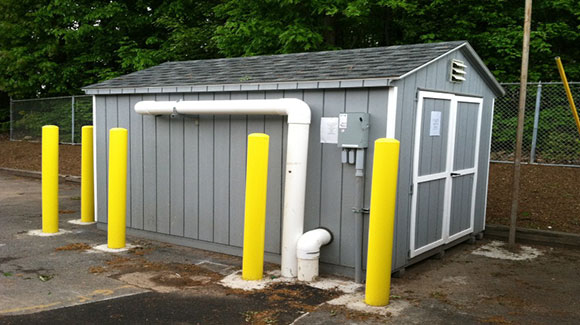Project Description
Chlorinated volatile organic (CVO) contaminants, primarily tetrachloroethene (PCE), detected in soil and groundwater due to releases from an on-site dry cleaners as well as in sub-slab and indoor air samples collected from several leasehold spaces within a multi-unit retail strip center at levels required remediation to achieve compliance with NJDEP regulations.
The extent of the CVO contamination detected in soil and groundwater at the site was defined to enable transitioning of this project to the remediation phase and confirmed that a treatment system was necessary to mitigate the potential infiltration of subsurface vapors into the building. Accordingly, Whitestone proposed actions to remediate soil and subsurface vapor, evaluate treatment options for a full-scale groundwater remediation, and address off-site groundwater impacts.
The proposed work for remediating the soil and subsurface vapors consisted of installing and operating a soil vapor extraction (SVE) system and a sub-slab depressurization system (SSDS), respectively. The SVE/SSDS required an air permit from NJDEP and performing a pilot test and post-installation sampling and analyses. The proposed actions for groundwater included an initial, focused phase to evaluate treatment options to be used to select a full-scale groundwater remediation. The focused groundwater testing consisted of injecting an inert biodegradable tracer dye into an injection well installed in the test area and monitoring the radial distribution of the injection. Selection and implementation of a full-scale groundwater remediation will occur after the soil remediation has been implemented and the effect on future groundwater quality fully evaluated.
Whitestone coordinated and oversaw the installation of the SVE and SSD systems. The components of each system were combined to the degree practicable, and the two systems were installed simultaneously to minimize the disturbance to the dry cleaner tenants and their customers and to reduce the overall installation time frame and cost. Each system was installed to remediate areas beneath tenant spaces that adjoin the dry cleaners (e.g., restaurant) while not having to actually access those retail spaces.
The SVE system uses a blower to evacuate contaminated soil gas from the subsurface through a series of vertical extraction wells installed through the floor of the dry cleaners. Evacuation of the soil gas induces volatilization of the contaminants (i.e., PCE and its breakdown products) in the subsurface and transfers the contaminants from the subsurface soil to the air-stream created by the vacuum. The contaminants in the air-stream are conveyed through piping to an outdoor treatment system that was located behind the dry cleaners. The contaminants are removed from the air-stream using granular activated carbon, and the treated air is discharged to the atmosphere. Samples of the treated air are collected and analyzed periodically to confirm that the system is operating as designed. The SSDS is similar to the SVE system, however, targets the shallower/upper portion of the subsurface and addresses the vapors that are accumulating immediately beneath the building’s concrete floor. The SSDS utilizes the same equipment that was installed for the SVE system.

